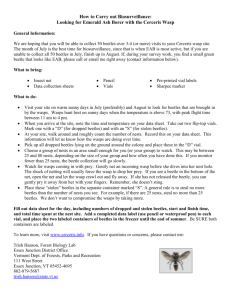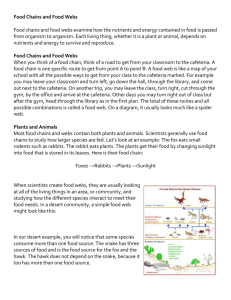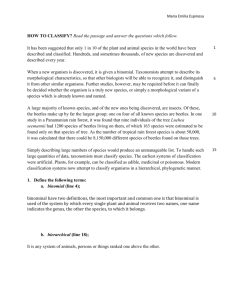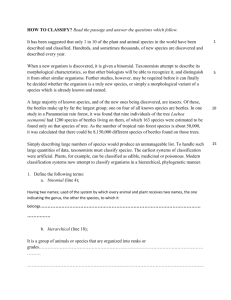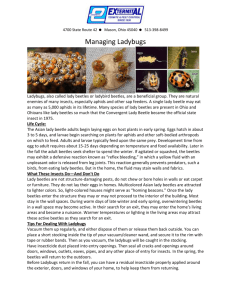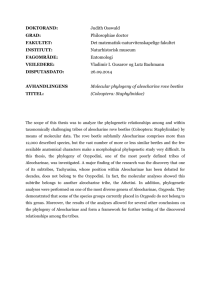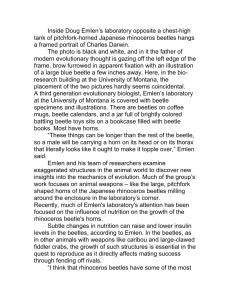Coleoptera
advertisement
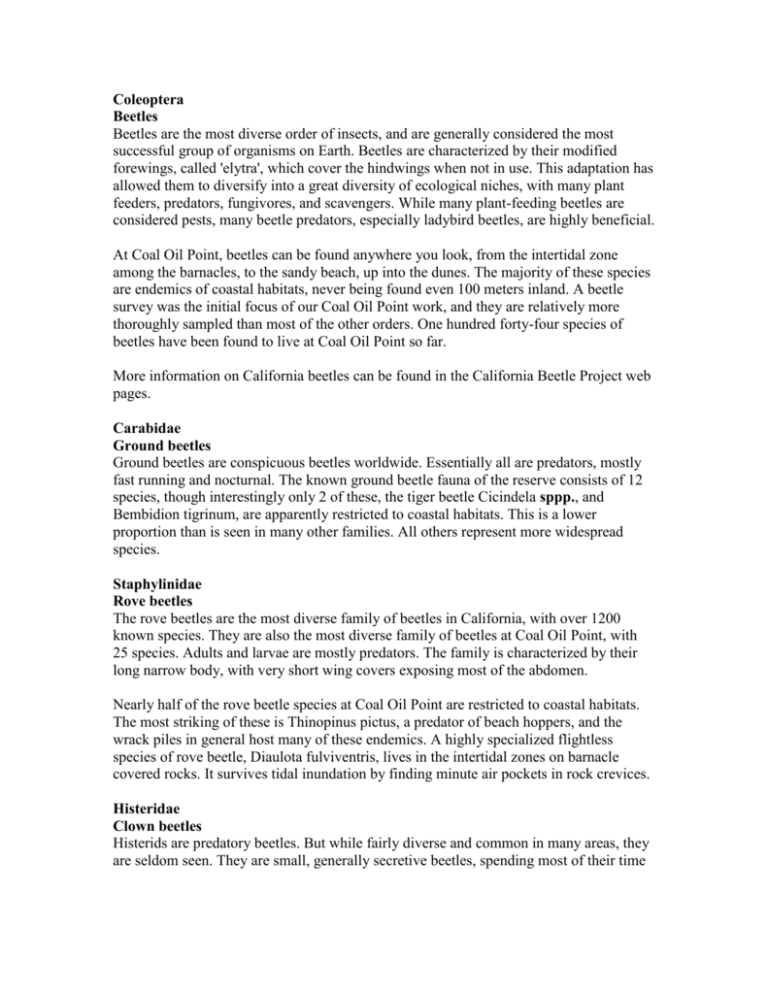
Coleoptera
Beetles
Beetles are the most diverse order of insects, and are generally considered the most
successful group of organisms on Earth. Beetles are characterized by their modified
forewings, called 'elytra', which cover the hindwings when not in use. This adaptation has
allowed them to diversify into a great diversity of ecological niches, with many plant
feeders, predators, fungivores, and scavengers. While many plant-feeding beetles are
considered pests, many beetle predators, especially ladybird beetles, are highly beneficial.
At Coal Oil Point, beetles can be found anywhere you look, from the intertidal zone
among the barnacles, to the sandy beach, up into the dunes. The majority of these species
are endemics of coastal habitats, never being found even 100 meters inland. A beetle
survey was the initial focus of our Coal Oil Point work, and they are relatively more
thoroughly sampled than most of the other orders. One hundred forty-four species of
beetles have been found to live at Coal Oil Point so far.
More information on California beetles can be found in the California Beetle Project web
pages.
Carabidae
Ground beetles
Ground beetles are conspicuous beetles worldwide. Essentially all are predators, mostly
fast running and nocturnal. The known ground beetle fauna of the reserve consists of 12
species, though interestingly only 2 of these, the tiger beetle Cicindela sppp., and
Bembidion tigrinum, are apparently restricted to coastal habitats. This is a lower
proportion than is seen in many other families. All others represent more widespread
species.
Staphylinidae
Rove beetles
The rove beetles are the most diverse family of beetles in California, with over 1200
known species. They are also the most diverse family of beetles at Coal Oil Point, with
25 species. Adults and larvae are mostly predators. The family is characterized by their
long narrow body, with very short wing covers exposing most of the abdomen.
Nearly half of the rove beetle species at Coal Oil Point are restricted to coastal habitats.
The most striking of these is Thinopinus pictus, a predator of beach hoppers, and the
wrack piles in general host many of these endemics. A highly specialized flightless
species of rove beetle, Diaulota fulviventris, lives in the intertidal zones on barnacle
covered rocks. It survives tidal inundation by finding minute air pockets in rock crevices.
Histeridae
Clown beetles
Histerids are predatory beetles. But while fairly diverse and common in many areas, they
are seldom seen. They are small, generally secretive beetles, spending most of their time
underground. When disturbed they can retract their head and appendages, much like a
tiny turtle.
Seven species of histerids have been found at Coal Oil Point, all but one of which are
coastal specialists. Most of these species are found beneath beach wrack, where they prey
on the eggs, larvae and pupae of wrack breeding flies. A beautiful black and red dune
specialist, Spilodiscus sellatus, is suspected also to occur at the reserve. But it has not
been confirmed yet.
Hydrophilidae
Water Scavenger beetles
Most adult water scavenger beetles are, unsurprisingly, aquatic scavengers. The Reserve's
aquatic habitats include Devereax slough, which hosts a couple of salt-tolerant
hydrophilids. There are also a few species found in the freshwater dune pond, as well as
in the vernal pools in the appropriate season. But not all hydrophilids are aquatic.
Probably the most common hydrophilid at Coal Oil Point is Cercyon fimbriatus, which
lives in rotting wrack.
Coccinellidae
Ladybird beetles
Ladybirds are among the best known and best-loved beetles. As predators of plant
feeding insects, especially aphids and other homopterans, many species have been great
allies in the fight against agricultural pests. This has led to many ladybirds being
introduced outside their native ranges. Nearly one third of California's 180 ladybirds have
been introduced from elsewhere.
Nineteen species of ladybirds have been found at Coal Oil Point. Most of these are
native, and most are also widespread species. Unlike most beetle families, there don't
appear to be any species restricted to coastal habitats.
Tenebrionidae
Darkling beetles
With over 300 species, California is home to a great diversity of darkling beetles.
Members of this family are common everywhere, but especially in drier areas. Flightless
'stink beetles' in the genus Eleodes are conspicuous in a variety of habitats throughout the
state. But while these large, slow beetles exemplify the family in some ways, many
Californian darkling beetles look nothing like these.
Coal Oil Point is home to at least 7 species of darkling beetles, including several coastal
specialists. The small, ladybird-like Phaleria rotundata is found only in sandy coastal
areas, as are Epantius obscurus and two species in the genus Coelus. One of these, the
Globose Dune beetle (Coelus globosus) has become rare throughout its range, and is a
state 'species of concern'.
Chrysomelidae
Leaf beetles
As their common name suggests, leaf beetles are plant feeding beetles. Most are colorful,
conspicuous beetles, frequently restricted in their feeding to one or a few similar plant
species.
While 10 species of leaf beetles are known from Coal Oil Point, none seem to be
restricted to coastal habitats. Some, like the Cucumber beetle (Diabrotica
undecimpunctata) are very widespread. One species of particular interest is the
eucalyptus feeding Trachymela sloanei. This species was newly (and accidentally)
introduced to our area from its native Australia in just the past few years. For fans of nonnative eucalyptus, this beetle is considered a pest. For others who consider eucalyptus
itself an invasive pest, the beetle is a welcome ally.
Curculionidae
Weevils or Snout beetles
Weevils are practically defined by their 'snout'. This elongated portion of the head bears
the mandibles and other mouthparts at its tip. This is used by the females of most species
to chew holes into plant material in which they lay their eggs. Adults and larvae of all
weevils are plant feeders. The group also contains the notorious bark beetles (formerly
recognized as a separate family Scolytidae). With over 600 species in California, the
weevils are our second most diverse family of beetles (behind Staphylinidae).
Coal Oil Point hosts 7 species of true weevils (Curculionidae), in addition to two species
in more primitive weevil families (on each of Anthribidae and Brentidae). Coastal
specialist weevils include the dune inhabiting Trigonoscuta, and the driftwood feeding
Elassoptes marinus.
Collembola
Springtails
Springtails are a large order of minute insects. They take their common name from a
forked organ extending from the end of the abdomen of most species that can be used to
propel the insect hundreds of body lengths away, putting them among the top ranked
insect jumpers.
Springtails may be incredibly abundant, occurring in great numbers in and around wrack
and other decaying vegetation. However, because most are less than 2 mm in length, they
are rarely noticed. They are nonetheless among the most important scavengers at Coal Oil
Point, as well as in most terrestrial environments. We have found four different species of
springtails at the Reserve, though there are doubtlessly more.
Archaeognatha
Jumping bristletails
The jumping bristletails are an inconspicuous group, looking much like their better
known cousins, the silverfish. Like silverfish they are wingless, scaly scavengers. Their
main claim to fame is a remarkable jumping ability. A braided cord-like muscle running
the length of the body can be rapidly contracted to pull the head and tail downward,
launching the insect several centimeters into the air. The scientific name of the order
means 'old mouth', referring to the relatively primitive mouthparts of these insects.
Archaeognatha is an extremely ancient order, and are considered living fossils. We have
identified a single species at Coal Oil Point.
Odonata
Dragon- and Damselflies
The 'odonates' are a well known group of exceptional aerialists. These insects have
attracted much popular attention, and they are gaining on butterflies with their own
'watchers' groups. Dragonflies and damselflies are predators in both the adult and
immature stages. The immatures are little aquatic monsters, with a grotesque extensible
lower lip ('labium') that is uses to snatch mobile prey ranging from mosquito larvae to
tadpoles and small fish.
Many biologists have become interested in the complex courtship and mating behavior of
odonates. Most are highly territorial, with males staking out good oviposition sites, and
defending them against other males. After mating males will often maintain their hold on
the females to ensure she fertilizes eggs with his sperm before mating again (some males
can remove from females the sperm from previous mates.)
The dragonfly fauna of Coal Oil Point has been compiled by local enthusiast Nick
Lethaby. XXX species are known. In addition we have collected a single damselfly
species at the Reserve, though there are likely more.
Lepidoptera
Butterflies and Moths
The Lepidoptera is characterized by their scaly wings, which is what 'lepid-optera' means.
While butterflies are much better known, they are vastly outnumbered by their moth
relatives. The differences between these groups is often emphasized (butterflies being
day-flying, brightly colored, and having knobbed antennae), but they share many more
similarities. All develop from a plant-feeding caterpillar, which transforms into a pupa (or
'chrysalis' as the butterfly pupa is generally called) on its way to becoming a winged
adult.
The butterfly fauna (25 species) of Coal Oil Point is well known thanks to the efforts of
local enthusiast Nick Lethaby, who provided our species list. The moths at the Reserve
have not been as well studied. Though we've collected many, the malaise trapped
specimens are difficult to identify. Some additional moth-specific collecting will be
needed to develop a good idea of their diversity.
Butterflies below are linked to separate species pages for each, as part of our Butterflies
of Santa Barbara County webpage. Each will open in a separate window.
Siphonaptera
Fleas
Fleas are notorious pests. They are wingless, high-jumping blood suckers, well known to
dog and cat owners everywhere. They have also been implicated as vectors of a number
of human diseases, most notably bubonic plague (transmitted from rodents to humans by
flea bites). Though in reality most fleas are harmless and ubiquitous cohabitants of birds
and small mammals, most people will be disconcerted to learn that plague does in fact
occur in California, and is rarely but occasionally transmitted to people by fleas from
ground squirrels. This is not a major concern at Coal Oil Point, but awareness and caution
is always advisable (visit the CDC for more information:
www.cdc.gov/ncidod/dvbid/plague/index.htm).
The lone flea we have found at Coal Oil Point was in the opening of pocket gopher
burrow.
Other arthropods
Here we provide photos of a number of additional miscellaneous arthropods which you
may encounter at Coal Oil Point. This does not begin to do justice to the diversity and
abundance of some of these, and we hope to expand these pages in the future. The wrackfeeding beach hoppers (amphipod crustaceans) are especially conspicuous at the Reserve.
The Reserve's spiders also certainly deserve additional treatment, as there are many dune
specialists.

